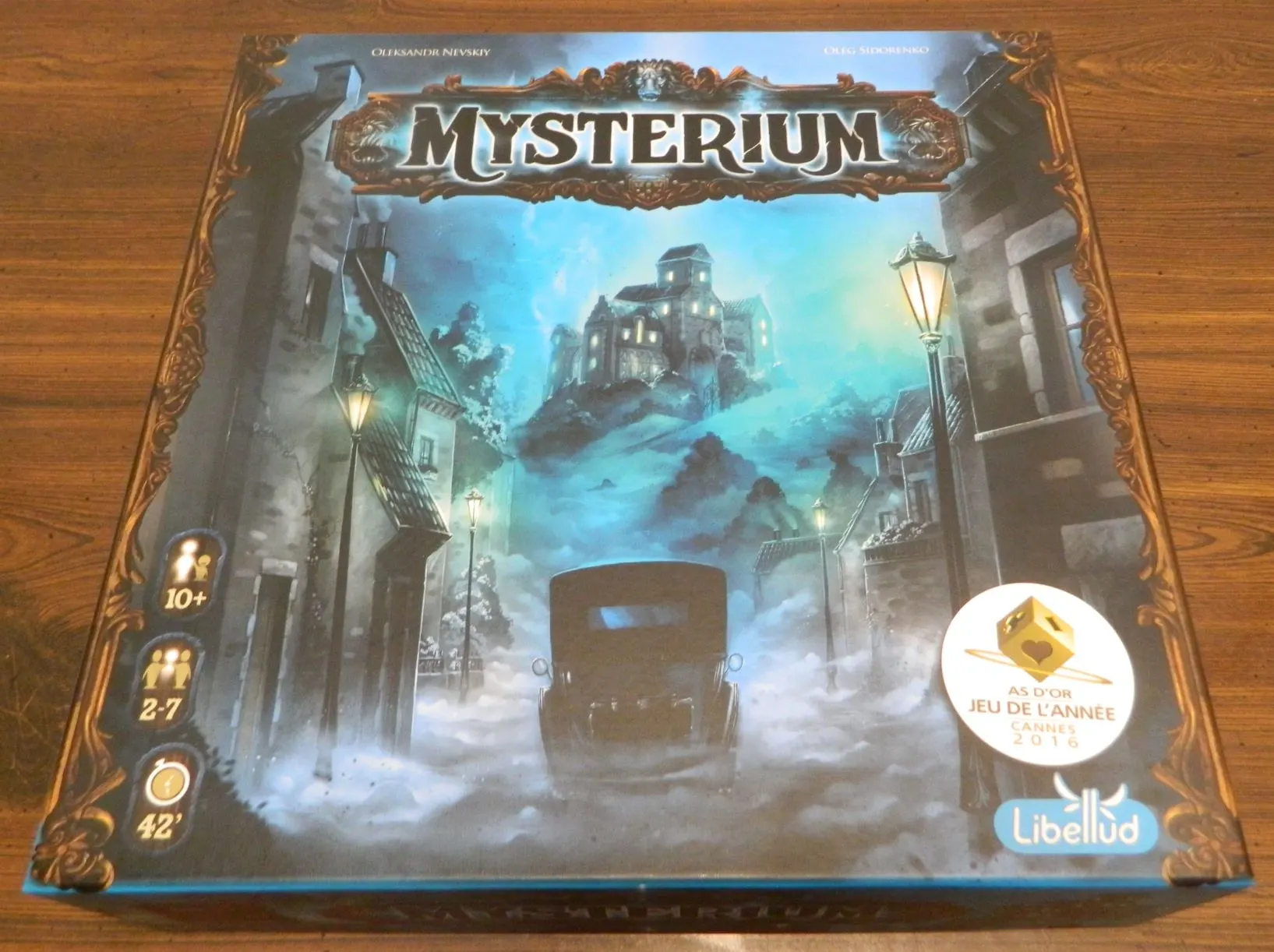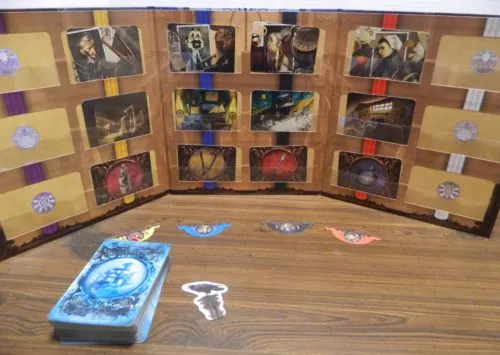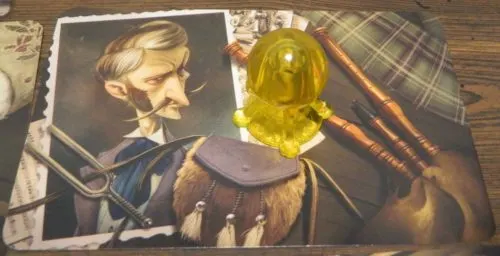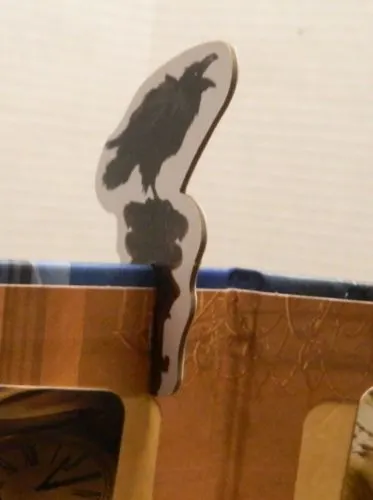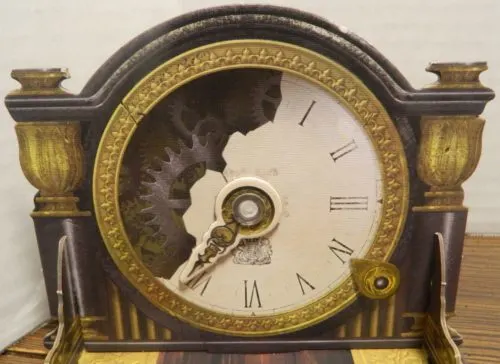I would say that I have always been a fan of the deduction genre of board games. There is just something really satisfying about being able to solve a good mystery. This is why the genre is a natural fit for board games. For many years Clue was the king of deduction board game. Clue gets a bad wrap at times as it does rely on a little too much luck and too much time is wasted moving around the mansion. I have always been a fan of the basic deduction mechanics underlining Clue, but I have always wanted a game that took those mechanics and crafted a better game around them. I have played a few good deduction games in the past, but I have yet to find a perfect deduction game. Mysterium is a game that I have been wanting to play for quite some time as it sounded like a really interesting take on the deduction genre. The game is highly rated as well. Mysterium is a clever deduction game mixing together some interesting mechanics to generate a truly enjoyable experience that doesn’t quite live up to its reputation.
How to Play Mysterium
Setup
- The players will choose which player will play as the ghost. The rest of the players will play as psychics.
- Each physic player will choose a color and take the following components of that color:
- 1 intuition token
- 1 sleeve
- 1 clairvoyancy level marker
- clairvoyancy tokens depending on the number of players (including the ghost player)
- 2-3 players – 0
- 4-5 players – 4 (numbered 1-4)
- 6-7 players – 6
- The ghost player will take the corresponding components:
- culprit tokens equal to the number of players starting with token #1
- the ghost tokens
- the vision cards
- the game screen
- The ghost player will shuffle the vision cards and draw seven to form their hand.
- The clock board is assembled and the hour hand is turned to one. The clock is then placed on the table along with the sand timer.
- The clairvoyancy track is set up with the side corresponding to the number of players placed face up. Each psychic player places their clairvoyancy level marker on the zero space on the track.
- The players will choose the difficulty that they would like to play. This along with the number of players determines how many character/location/object cards will be used and how many crow tokens the ghost player will get to use. The following chart shows how many character, location, and object cards will be used in the game.
-
Number of Players 2 3 4 5 6 7 Easy 4 5 5 6 6 7 Medium 5 6 6 7 8 8 Hard 6 7 7 8 9 9
-
- Randomly draw character, location, and object psychic cards based on the table above. Place the cards face up on the table with the progress bars placed between the different sets of cards.
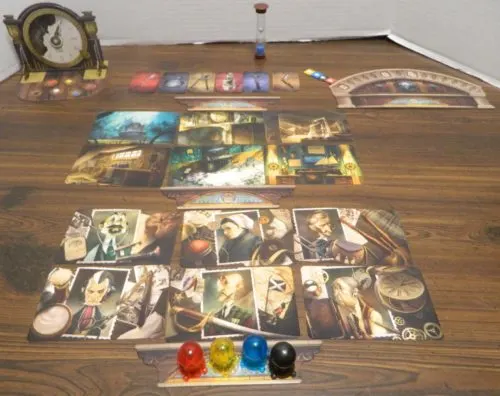
- Find the ghost cards whose numbers match those of the cards just drawn. The ghost player will sort these cards by their type and shuffle each pile separately. They will then draw cards from each pile and place one in each corresponding spot on their game screen for each player playing the game. The cards that aren’t used are returned to the box with the players not looking at them.
Playing the Game
Mysterium is played in two different phases. The first phase is called “reconstruction of events”. This phase consists of up to seven rounds. If the psychics successfully complete the reconstructions of events the players will then move onto the “revealing the culprit” phase.
Reconstruction of Events
During setup the ghost assigned a character, location and object to each player when they placed the cards behind their game screen. The objective of reconstruction of events is to get each player to guess the character, location and object that was assigned to them. Players will begin by trying to guess their character card. They will then move onto the location and finally will try to guess the object. The ghost player has seven rounds to try and get all of the psychics to guess all three cards. Each round consists of two steps.
Visual Interpretation
In this step the ghost player will try to give hints to each psychic in order to get them to guess their character/location/object.
Giving Vision Cards to Psychics
The ghost player begins this process by choosing one of the psychics. They will then look through the vision cards in their hand to try and find cards that may apply to what they are trying to get the chosen psychic to guess. The ghost player chooses one or more cards and passes them face up to their chosen psychic.
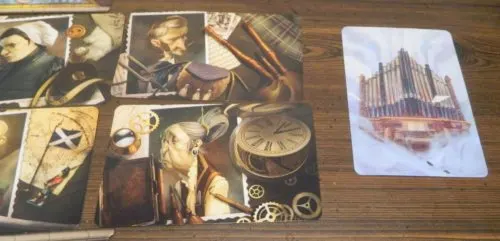
The ghost player wants one of the players to guess the card in the top right corner. They have played the organ card to try to lead the player to choose the musician.
To indicate that they game a detective a card(s) they will push the corresponding ghost token against their game screen to indicate that they can’t give any more cards to this player for the rest of the round.
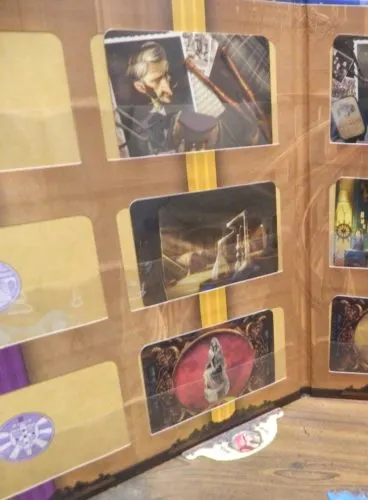
The ghost player has given the yellow player their vision cards for this round which is indicated by the marker being placed next to the game screen.
The ghost player will then draw new vision cards from their deck until they have seven cards in their hand. If the draw pile ever runs out of cards the player shuffles the discard pile in order to form a new draw pile. The ghost player will then choose the next psychic to give cards to. This process is continued until all of the psychics have received at least one card. At this point the timer is turned over and players have until the timer runs out to place their intuition tokens.
As soon as players start receiving their vision cards they can start interpreting them in order to figure out what character/location/object card the ghost is trying to guide them towards. Players can work together in order to try and figure out what cards the ghost is leading each player towards. The ghost can listen to what the players say to determine what cards they should play in the future, but they may not give any verbal or visual clues to tell players if they are on the right track. When a player has made their choice they will place their intuition token on the corresponding card. Players may change where they place their token until the timer runs out. Two or more players may place their intuition tokens on the same card even though at least one of them will be wrong.
Crows
At the beginning of the game the ghost player will receive a number of crow tokens depending on the difficulty.
- Easy – One crow that can be used each round.
- Medium – Three crows that can only be used once before they are discarded for the rest of the game.
- Hard – One crow that is discarded for the rest of the game once it is used.
The crows can either be used during the reconstruction of events or the revealing the culprit phases. When a player uses a crow they can chose any number of vision cards from their hand that they no longer want and discard them. They will then draw the same number of cards from the draw pile.
Using Clairvoyancy Tokens
In addition to playing their intuition tokens before the timer runs out, the players also have the option to play their clairvoyancy tokens. Each player has two types of clairvoyancy tokens. The token with a green check mark is used to indicate an intuition token that a player thinks is on the right card. The clairvoyancy token with a red x on it indicates an intuition token that a player thinks is on the wrong card. When placing a clairvoyancy token it should be placed where it points directly to one of the intuition tokens.
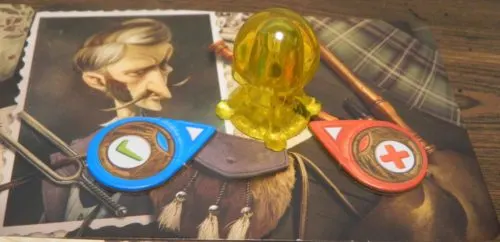
The blue and red players have played a clairvoyance token on the yellow player’s intuition token. The blue player think the yellow player is right. The red player thinks the yellow player is wrong.
In each round the player can play as many of their clairvoyancy tokens as they want but there are a couple limits. First a player may not place a clairvoyancy token on their own intuition token. A player may not play both a green check mark and a red x to the same intuition token. Multiple players may play a clairvoyancy token to the same intuition token though. Tokens may be moved, added or removed until the timer runs out.
All clairvoyancy tokens used will not be available again until after the fourth round.
Spectral Manifestation
When the timer runs out the ghost player will tell the players how well they did. The ghost will reveal the results one player at a time. To indicate whether a player was correct or incorrect they will move their intuition marker.
If a player placed their intuition marker on the right card the ghost player will move their intuition marker to the next set of cards. In the next round this player will have to guess their location/object card. The card that the player had their intuition token on will be placed inside the psychic’s sleeve. Any psychic who placed the green check mark clairvoyancy token on the intuition token will move their clairvoyancy marker one space forward on the clairvoyancy track. Anyone who placed a red x token will discard it to the corresponding spot on the clock board. Finally the psychic will discard all of the vision cards that they were given.
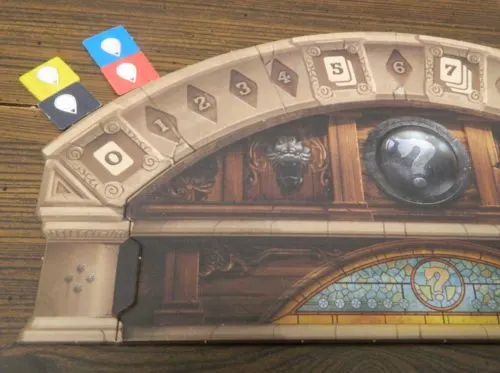
Both the red and blue player correctly played one of their clairvoyancy tokens so they moved their marker forward one space along the track.
If the player incorrectly placed their intuition token the ghost player will move their token behind their current set of cards. In the next round they will once again try to guess the correct card. Anyone who placed the red x clairvoyancy token on the intuition token will move their clairvoyancy marker one space forward on the clairvoyancy track. The psychic will keep their vision cards in front of them to hopefully help them in the next round.
The ghost will then move onto revealing whether the next player was right or wrong.
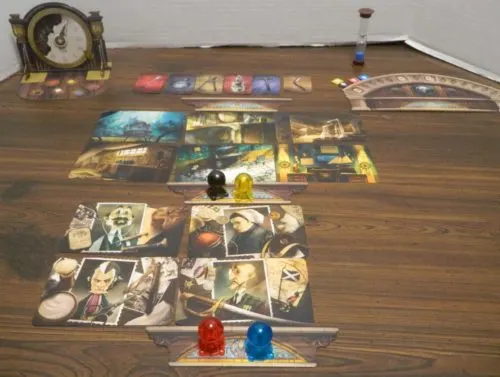
In this round both the yellow and black player successfully guessed their character card. The red and blue played guessed incorrectly.
Once a player has successfully guessed their character, location, and object they have finished this phase of the game. They will no longer receive vision cards and will no longer make guesses. They will move their clairvoyancy marker forward one space for each turn remaining on the clock. For the rest of the phase the player can help the other psychics guess their cards, and they can still play clairvoyancy tokens.
When the ghost player has revealed the fate of all of the players, the game will move to the next round. The hour hand on the clock is moved forward one hour. If the clock hits the last space on the clock all of the players will immediately lose the game.
If at the end of a round all of the players have successfully found all three of their cards the players will move onto the next phase of the game.
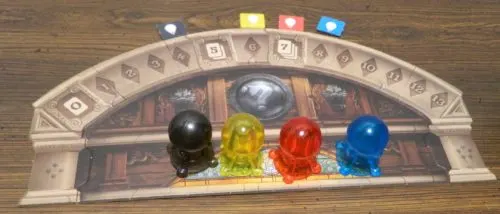
All of the players have finished the first phase of the game so the players will move onto the second phase.
Revealing the Culprit
At this point all of the psychics have found all three of their cards. The psychics are now tasked with determining who committed the crime, where they did it, and what object they used.
To begin all of the remaining character/location/object cards are discarded along with the progress boards. The psychics will then remove the cards from their sleeves and place them into their own group. One of the ghost tokens is placed next to each set of cards which will indicate what number that set of cards will represent. The players will collect their clairvoyancy tokens.
The ghost player will analyze the vision cards in their hand along with the different sets of cards on the table. The ghost player will choose which set of cards will be the culprit/location/object. The ghost will indicate their choice by choosing the corresponding culprit token and placing it face down. They will then choose three vision cards with one representing each card from the set that they have chosen. They will shuffle these three cards together.
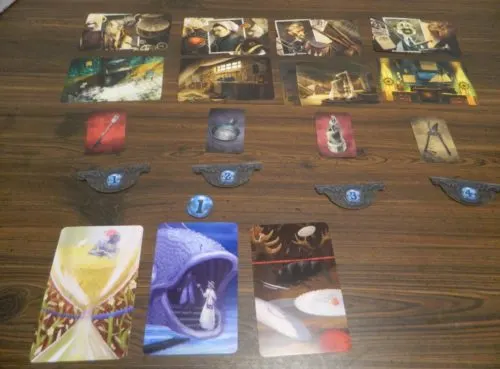
This ghost player has chosen the first set of cards to be the culprit. They have chosen the sand timer card to reference the clock in the character’s picture. They have chosen the fish card to represent the fish in the location card. They have chosen the plates and utensils to reference the fork card.
The players will then start to see the vision cards chosen by the ghost and start voting on which set of cards is the culprit. At this point the psychics may no longer communicate. Depending on how far their clairvoyancy marker made it on the clairvoyancy track the players will get to see a different number of the vision cards before voting. Players who were unable to reach the second section of the track (after the two card symbol) will only get to see one of the cards before voting. Players who don’t make it past the three card symbol will only get to see two of the cards. Players who make it past the three card symbol will get to see all three cards. When a player votes they will place the clairvoyancy token with the number of their choice into their sleeve.
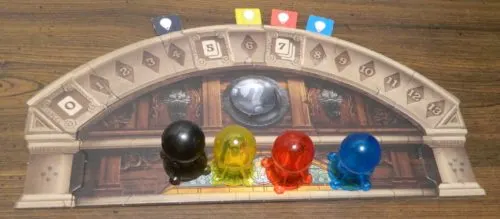
The blue and red players will get to see all three cards. The yellow player will get to see two of the cards. The black player will only get to see one of the cards.
When everyone has voted the players will reveal their votes. If a majority of players vote for one of the sets of cards that set of cards is the players’ choice. If there is a tie the player who made it furthest on the clairvoyancy track will break the tie. If there is still a tie the tied set that the oldest player voted for will be the group’s choice.
The ghost will then reveal the culprit token they chose. If it matches the set chosen by the group all of the players will win the game. If it does not match the set chosen by the players all of the players will lose the game.
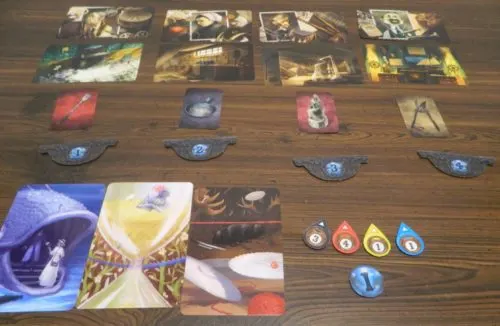
The ghost player has chosen set one to be the culprit. One player picked set three and one picked set four. Two players picked set one so the group’s choice was set one. As that matched the set chosen by the ghost the players have won the game.
My Thoughts on Mysterium
In Mysterium someone has been murdered. After a long time with no one being able to solve their murder the ghost of the victim has finally decided that enough is enough. The ghost contacts a group of psychics hoping that it can finally give them the clues necessary to find their killer. Things are not so easy though as the ghost can only relay this information to the psychics through visions so things can get messed up along the way. Can the ghost give the psychics enough clues to solve the murder before they run out of time?
Mysterium is a deduction game at heart but it is unlike any other deduction game that I have ever played. Basically Mysterium plays like what you would expect from a combination of Clue and Dixit. I would add in that there are some glimpses of Codenames as well. In Clue the objective is to figure out the suspect, the weapon, and the location where the murder was committed. This is done by giving each player some of the cards and players asking questions of one another to figure out what cards none of the players control. Things are similar in Mysterium as you are trying to figure out the same pieces of information. The process of getting that information is quite a bit different though. As Mysterium is a cooperative game it had to tweak the mechanics so that all of the players could work together. The ghost player knows the various suspect/location/weapon combinations and they have to give clue cards that lead each player to the suspect, location, and weapon cards assigned to them.
Before playing the game you might think this sounds pretty straightforward. How hard could it be to get a player to choose a specific set of cards when you have seven rounds to get the player to correctly guess only three cards. This is more difficult than it first appears though as the clues you have to work with are not particularly specific. The clue cards are pretty abstract on purpose mostly featuring fantastical combinations of different objects like something that you might see in a dream. The pictures on the vision cards are very similar to something that you would find in Dixit. None of the vision cards directly point towards a specific person, place or weapon. Instead the ghost player has to be more creative in how they use the vision cards. For example as I showed in the how to play section you may have to get one of the players to select the musician (the man with several instruments in his picture). To guide a player towards this suspect you probably want to play any vision cards that feature instruments that you have in your hand as it will likely lead them towards picking the right card. This is still a pretty straightforward clue in Mysterium as there will be times where you have to be quite a bit more abstract in order to give clues for some of the suspects/locations/weapons.
For this reason players have to be on the same wavelength in order to have a good chance of winning the game. If players are not on the same wavelength one clue card could easily send a player down the wrong path. Players could notice something on a vision card that the ghost didn’t see sending them towards one of the other cards. If the ghost player can’t get them off of this train of thought quickly they could waste several rounds in the same section making it quite a bit harder to win the game. On the other hand players that are on the same wavelength could breeze through the game. Groups that think a lot alike could use pretty minor clues in order to get their teammates to guess correctly. When choosing cards the ghost player really needs to pay attention to which features they think the players will focus on and how they will interpret them. If the ghost player doesn’t do a good job picking the clue cards the players will have a very hard time winning the game.
The first thought I had when I started playing Mysterium is that the game is quite clever. I have played quite a few deduction games over the years and I can’t recall one that played quite like Mysterium. I have always liked the mechanic in Clue of figuring out the culprit, location and weapon used in a crime. I like the mechanic of asking other players about the cards in their hands as it requires quite a bit of strategy. Unfortunately there isn’t much else to Clue as the roll and move mechanics hurt the game. Mysterium replaces this with a cooperative mechanic where players have to interpret clues in order to figure out the correct suspect, location and weapon. This is a really interesting twist on your typical deduction game and it allows players to play cooperatively.
Being a fan of cooperative board games I had a strong feeling that I would enjoy Mysterium. For the most part I did as it is a fun cooperative experience. Like most cooperative games the players have to work well together in order to succeed. The game has two distinctive roles that have to be in sync if players want a chance of winning the game. The ghost player has to be in sync with the other players so they can give them clue cards that they will interpret correctly. The psychics also have to work well together in order to interpret all of the clue cards correctly in a short amount of time. Playing as the ghost and trying to figure out which clue card to give is fun and requires a lot of interesting decisions as you try to figure out clever ways of using the cards you have available to you. Playing as a psychic is also fun as you have to try to interpret those abstract clues.
In general I am not a big stickler for themes in board games. A good theme is always appreciated but I will always prefer a game with good gameplay and a bad theme over a game with bad gameplay and a great theme. While Mysterium could have just pasted on the ghost trying to reveal their own murderer theme, I think it works pretty well for the most part. This will obviously depend on the group as you could easily play the game in a way where the theme is non-existent. If your group is not in the right mood the theme won’t really do anything for you. Groups that put in the effort though can actually build an engaging theme around the game. From the mood of the room to how the ghost handles their role can add quite a bit to the atmosphere. In the right groups it could really feel like you are playing the board game version of contacting spirits through a Ouija board.
Another reason that Mysterium stands out is the game’s component quality. For the most part I thought the game’s components were great. The artwork in the game is fantastic. The vision cards can be quite abstract but they are really well done. The rest of the artwork is really good as well as it does a really good job helping to reinforce the game’s theme. In addition to the artwork the quality of the components is quite good. Most of the components are made from cardboard, but the components feel solid for the most part. If you take care of the components there should be no reason for them not to last a really long time.
Mysterium is good game that I really enjoyed playing. It is not quite perfect though. I don’t think it quite lives up to its reputation which would have been really hard to do as the game is rated around the 200th best board game of all time on Board Game Geek.
I would say that easily the biggest issue with Mysterium is the fact that the game can rely on quite a bit of luck. Good players will be able to overcome some bad luck, but your fate will be somewhat dependent on how much luck you have. Most of this luck comes from the fact that the vision cards that the ghost player has access to will play a big role in how well you do. You will always have to be a little abstract with the clues you give as few of the vision cards can be used to directly point to a specific card. There is usually something on one or more of the cards that you can use as a hook to guide players towards the right cards. There will be times when you have no vision cards that apply to the desired card though. In these situations there isn’t much that you can do. If you have crows left you can use one to change the cards in your hand. Outside of the easy difficulty though you have a pretty strict limit on how many times you can reset your cards. Otherwise you can give one of the players a card that isn’t particularly relevant and hope they can randomly guess the right card. This could lead to you losing several turns though which can be the difference between winning and losing the game. Meanwhile if players are really lucky they could easily breeze through the game without too much trouble. With a game like Mysterium there was going to be some reliance on luck because you are forced to draw cards. I think the reliance on luck could have been reduced some though as there will be games where it will be really hard to win even if you play a good game.
The other main problem with Mysterium is the possibility for there to be quite a bit of downtime for the psychic players. This is all going to come down to how much time the ghost player takes to choose the vision cards for each player. This decision is important as it will determine how successful the players are. The ghost player wants to take enough time so they give good clues to the other players where they don’t lead them down the wrong path. At the same time though while the ghost player is contemplating what cards to use the other players are just sitting there waiting for the ghost player to make their choices. Once the ghost player starts giving out cards the psychic players can start trying to interpret the cards. There is still quite a bit of downtime in the game for the psychic players though. There really is nothing the game could have done to reduce this either. If the ghost player decides pretty quickly this won’t be a huge problem. If a player that suffers from analysis paralysis is the ghost though this could lead to some problems.
Should You Buy Mysterium?
Mysterium might not quite live up to its reputation but I thought it was a very good game. Mysterium basically takes your typical whodunit gameplay from Clue and puts a twist on it. Players have to figure out the correct suspect, location, and weapon but all they have to go on are vague clues given by the victim. One player needs to use abstract pictures to get players to guess the correct suspects, locations and weapons and eventually catch the killer. Meanwhile the other players have to analyze these abstract pictures to determine what cards they point towards. I have played quite a few different deduction games and I can honestly say that I haven’t played one quite like Mysterium before. The game is quite creative combining the picture analysis from a game like Dixit with the deduction mechanics of a game like Clue. These two mechanics might not share a lot in common but they work really well together creating a really fun cooperative experience. In the right group the theme as well as the components do a really good job supporting the gameplay. Mysterium does rely on a decent amount of luck at times though as you can’t win the game if you don’t get the right vision cards at the right times. There is also the potential for there to be quite a bit of downtime for the psychic players if the ghost player takes a long time to pick which pictures they will give to the players.
I think most people should enjoy Mysterium. If you like games like Dixit, cooperative games in general, or think the game’s concept sounds interesting you should have a lot of fun with Mysterium. If you don’t really care for cooperative games or Dixit, I don’t know if Mysterium will be for you. For most people though I would highly recommend picking up Mysterium.

